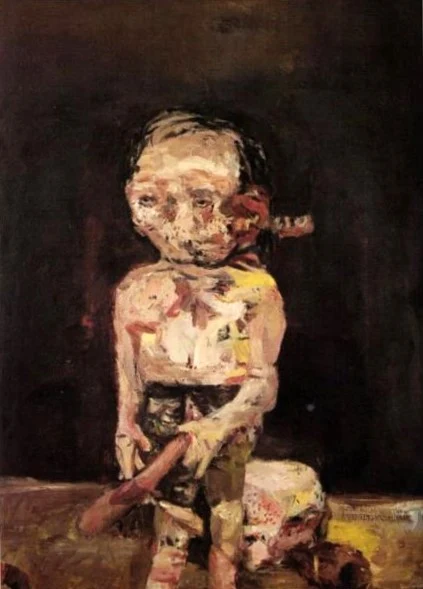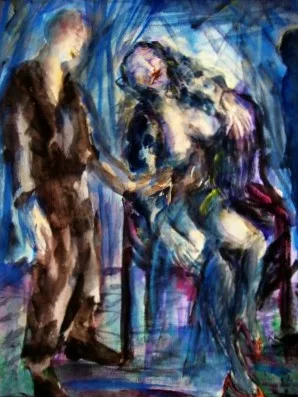Confrontation, Provocation, and the Power of Perspective
Georg Baselitz is an artist who refuses to play it safe. Throughout his career, he has embraced rebellion, both in his art and in his attitude towards the establishment. Baselitz is known for his raw, expressive style and his bold decision to literally turn his paintings upside down, a move that challenges our expectations of how art should be seen. Today, let's dive into Baselitz’s career and explore why his unapologetic approach continues to push the boundaries of contemporary art.
 |
| Georg Baselitz - Big Night down the Drain |
Post-War Roots: A Deeply Influenced Perspective
Baselitz was born Hans-Georg Kern in 1938 in Deutschbaselitz, Saxony, in what would soon become East Germany. Growing up in the shadow of World War II, his early life was steeped in the disarray of a shattered country. The destruction and trauma of war left a deep impression on Baselitz, driving him towards art as a means of making sense of a fractured world. This period of post-war turmoil is evident in his early work, characterized by rawness, violence, and an unflinching portrayal of the human condition.
In 1958, Baselitz moved to West Berlin to study art, where he was exposed to a world vastly different from the tightly controlled cultural environment of East Germany. His early work was influenced by both German Expressionism and the growing Abstract Expressionist movement, but Baselitz always had an urge to create something distinctly his own. He rejected abstraction as a purely aesthetic endeavor and sought instead to make work that was grounded in figuration yet subverted the norms of representational art.
 |
| Georg Baselitz - Evening |
Upside-Down Figures: A Revolutionary Approach
Baselitz’s decision to turn his paintings upside down, starting in 1969, remains one of his most iconic contributions to contemporary art. By inverting his subjects, Baselitz forces viewers to confront the act of seeing in a new way. It’s not about what the subject is, but how we perceive it. This inversion strips away the narrative context and places focus on the formal qualities of the painting, composition, color, texture.
This bold move was as much a philosophical statement as it was a stylistic choice. Baselitz once explained that turning his work upside down allowed him to liberate the content from its conventional associations. By disrupting the familiar, he invited the viewer to look at art differently, to question the boundaries between representation and abstraction. This approach was a direct challenge to the norms of both the art establishment and the viewing public, an assertion of independence that has come to define Baselitz’s career.
Heroes and Rebels: The Power of the Outsider
One of Baselitz’s most notable series is his “Heroes” paintings from the mid-1960s. These works feature monumental, disheveled figures, often soldiers or warriors, that seem to embody both strength and vulnerability. These heroes are not triumphant; they are scarred, weary, and often depicted in a state of disarray. This portrayal can be read as a reflection of the shattered ideals of post-war Germany, a statement on the fallibility of those who are traditionally considered powerful.
 |
| Georg Baselitz - Rebel (Heroes Series) |
The “Heroes” series was controversial at the time of its creation, partly because it challenged the glorified image of strength and victory that was prevalent in the national psyche. Baselitz’s heroes are human, flawed, and far removed from the idealized depictions of heroism. They reflect a society struggling with its past and uncertain of its future, a theme that resonated deeply in post-war Europe.
Embracing the Raw and the Primitive
Baselitz has often drawn inspiration from what he considers “primitive” forms of art, such as African sculpture and folk art. His work is deliberately raw, with thick, expressive brushstrokes and a disregard for conventional aesthetics. He embraces what is rough and unrefined, finding beauty in imperfection. This approach is not merely stylistic, it is a challenge to the polished, commercialized art that has often dominated the art world.
Baselitz’s sculptures, which he began creating in the 1980s, further reflect this fascination with the raw and the elemental. Carved out of wood with a chainsaw, these works are deliberately rough-hewn, their forms barely emerging from the splintered material. This embrace of the imperfect and the unpolished is a statement against the sanitized nature of modern culture and a return to something more visceral and authentic.
 |
| Georg Baselitz - The Apprentice |
A Legacy of Defiance and Reinvention
Baselitz has always been an artist of defiance, defying the expectations of the art world, defying political norms, and defying even the conventions of his own practice. His work is characterized by a relentless questioning of how we see and understand art. Whether through his upside-down paintings, his monumental depictions of flawed heroes, or his raw, primitive sculptures, Baselitz has consistently pushed the boundaries of what art can be.
In recent years, Baselitz has revisited many of his earlier themes, often reinterpreting his previous works in new ways. This process of revisitation and reinvention speaks to his belief in the ongoing evolution of the artist. For Baselitz, there is no final statement, no definitive work, only a continuous exploration, a constant questioning.
Baselitz’s influence on contemporary art cannot be overstated. His willingness to confront difficult themes, his embrace of the unconventional, and his commitment to challenging the viewer have made him a towering figure in post-war art. He reminds us that art is not about comfort, it is about confrontation, about pushing us out of our complacency and forcing us to see the world from a different perspective.



.jpg)







No comments:
Post a Comment